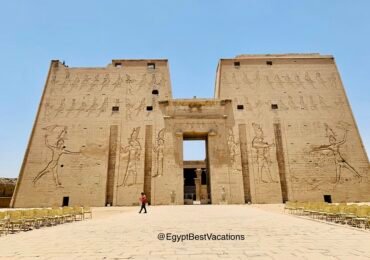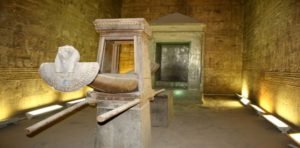Edfu is a small town located 110 km south of Luxor, 60 km north of Kom Ombo, and 105 km north of Aswan. Town of Edfu is famous for the Temple of Horus. The Temple of Horus in Edfu is the most intact temple in Egypt and one of the most beautiful temples built during the Greco-Roman period.
This temple is very intact, none of its elements are missing but the Sacred Lake and two obelisks. The Sacred Lake was on the east side of the temple but now vanished under the city’s modern houses. Two obelisks were located in front of the main gate of the temple.
Edfu Temple is fully inscribed with reliefs and hieroglyphs on its exterior and interior walls. Let’s take a quick tour of the temple.
Location of Horus Temple in Edfu
The Temple of Horus is located on the western bank of the modern town of Edfu. In ancient Egypt, Edfu was called (Behedt). It was Apollonopolis Magna during the Greco-Roman period. The Greeks identified Horus, the Egyptian deity, with their god Apollo.
Edfu’s modern name is derived from the Coptic name of the town (Etbou) or (Tebou). The Coptic name of the town was derived from the ancient name (Jebou), the name of the 2nd nome of Upper Egypt. This temple was built over a ruined temple from the time of Tuthmose III (1479-1425 BC). Tuthmosis III’s temple was built from the west to the east. But the this temple is built from the north to the south.
The Temple of Edfu is dedicated to Horus of Edfu (Hr-Bhdt). Horus is always portrayed as a falcon or a man with the head of a falcon. God Horus was married to the goddess Hathor. A magnificent temple is built for Hathor in Dendera, north of Luxor.
Every year, in the second month of the flood season, Goddess Hathor visits Edfu to reunite with her husband Horus. Her visit was like a grand ceremony called the “Beautiful Union” or the “Beautiful Marriage,” in modern terms the “Marriage Anniversary.” So, the Triad of the temple is Horus, his wife Hathor, and their son Ihy. Ihy or (Hr-sma-tawy), Uniter of Upper and Lower Egypt, is depicted as a child.
Construction of Edfu Temple
An inscription in the temple tells us that Ptolemy III had begun the construction of this temple in 237 BC. Then, temple was completed at the time of Ptolemy XII in 57 BC. So, it took the temple 180 years (237-57 BC) to be finished.
Another inscription tells us that the temple was built according to the plans and rules of Imhotep, the son of Ptah. Imhotep was King Djoser’s vizier and the builder of the Step Pyramid in Saqqara. During the Greco-Roman period, he was deified as the God of Medicine and Engineering.
First Pylon of the temple

The first pylon (main gate) of the temple is completely untouched, only the wooden door is missing. The pylon is 36 meters high. The two towers of the pylon are called Isis and Nephytis. There is a stairway on each tower that leads to the top of the pylon.
Two granite statues of Horus, shaped like a falcon, are just in front of the pylon. The top registers on both sides of the pylon represent the King making an offering to the various gods as well as the triad of the temple, Horus, Hathor, and Ihy.
The lower scene, which is the main scene on both sides of the pylon, depicts the King (Ptolemy XII) who smites Egypt’s enemies before Horus and Hathor. The winged sun disk, which still has a lot of its colors, is on the top of the facade.
The Open Court
The main gate (pylon) of Edfu temple leads to an open courtyard. It has 32 columns to the east, west, and south of the court. To the right and left of the pylon gate are scenes depicting the Ceremony of the Beautiful Meeting of Horus and Hathor. Two granite statues of Horus in front of the back door that leads to the Hypostyle Hall of the temple. Only one of the two statues is in very good condition, but the other is destroyed.
Main Hypostyle Hall of Edfu Temple
This magnificent Hypostyle Hall consists of 12 columns plus 6 more columns in the wall that separate the open court from the Hypostyle Hall. Two small rooms on the left and right side of the door to the hall. The right room has been called (pr-madjet) or (House/Room of Books) in modern terms is (library). The left room was called (pr-duat) or the (House/Room of the Morning). It was dedicated to the purification of the Pharaoh or the High Priest before the rituals began. Scenes on the walls and columns of the hall are religious scenes.
Second Hypostyle Hall
The back door of the main Hypostyle Hall leads into the second or inner Hypostyle Hall. This hall is dedicated to the rituals of the pharaoh. To the left of the door is a stunning scene depicting the construction and dedication of the temple of Horus by the pharaoh of Egypt. The scene begins when the pharaoh leaves his palace on a very dark night, gazing at the stars to set the foundation of the temple. Then, the king meets the representative of the god Horus on earth, a priest that wears the mask of Horus.
The pharaoh, with the help of the goddess Seshat, takes the measurements of the temple by a rope. Then, the pharaoh digs the foundation trench. Then he sets up the foundation bricks. At the end of the ceremony, the pharaoh offers the model of the gate of the temple to Horus, which means that the temple is finished and dedicated.
On the back wall of the hall, the pharaoh burns incense in front of the sacred bark of Horus, being carried on the shoulders of the priests. Two doors on the left wall of the hall. One of them leads to the laboratory of the temple and the other to the room of the Nile.
The Hall of Offerings of Horus Temple
The second Hypostyle Hall leads to the Hall of the Offerings. A door to the right of the hall leads to the ascending stairway to the roof of the temple. Another door to the left leads to the descending stairway from the roof to the ground floor. The priests used these stairs during the New Year’s Ceremony. The golden statue of the god Horus will be taken by the priests to the roof at dawn to catch the first sun rays of the New Year.
There is another hall and the sanctuary of the temple behind the Hall of Offerings. The door on the right of the next hall leads to the “purified place.” Another door on the left leads to the room of the god Min of fertility in ancient Egypt. Min has always been depicted with an erected phallus. Min’s cult center was Coptos, the modern town of Qeft, 50 km north of Luxor.
The Sanctuary of Edfu Temple
The Sanctuary of Edfu temple or the Holy of the Holies was known in ancient Egypt as (st-wrt) (the Sacred/Great Place). The sanctuary is a very restricted place, only two people had access to it, the pharaoh and the high priest of the temple.

The sanctuary is surrounded by ten chapels dedicated to different gods visiting the temple during the festivals, so they are like guest rooms. Inscriptions of the sanctuary of Edfu Temple tell us that the sanctuary is 19 cubits long and 13 cubits wide.
A small granite chapel made for the statue of Horus is found in the back of the sanctuary. This chapel was made by Pharaoh Necatenbo II, the last Pharaoh of the 30th Dynasty. The holy wooden bark is just in front of the granite chapel. This bark was made to take the golden statue outside the sanctuary or outside the temple at the time of the festivals.
The enclosure walls of the Temple of Horus in Edfu
The enclosure walls around the temple of Horus in Edfu are richly decorated with reliefs depicting different myths. The inner side of the right enclosure wall depicts the myth of the Red Hippopotamus. While the inner side of the left enclosure wall depicts the myth or play of Horus’ victory over Seth.
The Temple of Horus in Edfu is included in all of our Egypt trip types and in some of our Luxor Day Tours and Aswan Day Tours as well.
How to get the Temple of Horus in Edfu from Luxor?
To visit the Temple of Horus in Edfu from Luxor, there are several travel options depending on your preference for comfort, time, and budget:
1. By Nile Cruise or Dahabiya cruise
The most scenic and popular way to reach Edfu is by booking a Nile cruise or Dahabiya cruise from Luxor to Aswan. These cruises often include a stop at the Temple of Horus.
2. By Private Car or Taxi
Hiring a private car or taxi offers flexibility and a direct route to the temple.
- Advantages:
- Travel at your own pace and choose additional stops, such as Esna.
- Comfortable and faster than public transportation.
3. By Train
Edfu is accessible by train from Luxor on the Upper Egypt railway line. Take a train from Luxor to Edfu station (around 1.5–2 hours). From Edfu station, take a tuk-tuk or taxi to the temple (10–15 minutes).
- Advantages:
- Affordable and convenient.
- Enjoy views of the Nile Delta during the journey.
4. By Public Minibus
For budget travelers, minibuses are an inexpensive way to travel. Take a minibus from Luxor to Edfu (often involves transferring in Esna). From Edfu bus station, hire a tuk-tuk or taxi to reach the temple.
- Disadvantages:
- Less comfortable and slower.
- Limited departure schedules.
5. Private Tour from Luxor
Egypt Best Vacations offers a daily guided tours to Edfu temple from Luxor. These tours include transportation, entrance fees, lunch and tour guide.
Ways of how to get the temple of Horus in Edfu from Luxor are exactly similar if you want to get to the temple from Aswan.
Tips for Visiting the Temple
- Timing: Visit early in the morning to avoid crowds and heat.
- Guides: Consider hiring a guide to fully appreciate the history and significance of the Temple of Horus.
- What to Bring: Water, sunscreen, and a hat are essential for the desert climate.

